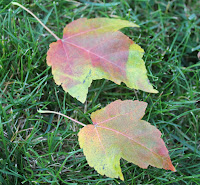I found out that I placed well in Warrior Dash this year. I was nineteenth in my age group, placing me at 343rd out of nearly eight thousand men and women. I’m feeling pretty good.
To be fair, I benefited from some help. My friend, Jason, gave me a hand out of a mud hole, and I glided past a line-up that would have cost me about five minutes. I simply dodged around them and slipped down the rappel line.
Help duly noted, but I earned it. I ran the flats, fast-walked the uphills and free-wheeled the downs. I glided up and over twenty-foot walls with mud-slick ropes and through a lateral wall of cargo nets, on which I kept stepping on the kid's shoes in front of me. He was a fit teenager, but had no technique. He’d swing his legs out, and then struggle to get his feet back on the ropes; whereas I pointed my toes in the direction I was moving, and ran through the netting. Once back on the ground, he took off like he was shot from a bow. I didn't catch him again until he was fumbling through the next set of obstacles.
On the ball field, I can turn a double play, and have made dive and slide catches while charging shallow pop flies in the outfield. In slow pitch, I’m usually good for a double, or a triple on a good day. I even get the occasional home-run-on-an-error. I can play baseball, basketball, volleyball (no polish here—but I can get the job done) and fly-fish, rock climb, run, canoe, mountain bike, swim, and so many other athletic endeavors that I enjoy immensely; as one could deduce by the alternating look of grim determination and the Labrador like look on my face that says, throw the ball, this is fun, throw the ball, oh please throw the ball...
My other strengths include a knack for the natural sciences, observation, and I have a vivid imagination.
I’m proud of all these abilities and get immense satisfaction from them. Which is great—for the ½ of 1 percent of my time that I spend pursuing them. I’m engaged. I’m fluid. I’m challenged—I’m happy.
The rest of the time, I’m a kangaroo in a house with a low ceiling. My skills make me kind of fun when we're playing outside; I can monkey with the best of them, and I can make up a pretty cool story on the fly.
However, my domestic skills are in serious want. One mother referred to the circumstance of when kids are at sports and the family arrives home late as a "crock-pot night."
“Ohhhh,” I said.
I’m thirty-six years old and the term “crock-pot night” is entirely new to me.
She explained, "You know, you start dinner in the crock-pot in the morning..."
"...then it's ready that evening!" I said, finishing her thought. Ah-ha!
How do these women know these things? Is it part of a domestic maven’s DNA? Or is does the domestic life engage them in a way that is lost on me?
We have two crock pots, I believe, that have been around since we got married—a decade and a half ago. I have never plugged it in and cooked something in it. Charley has, four or five times. I have not—ever. And I don’t really have any inclination to do so.
I have immense admiration for these women. Some are career moms, that go to their jobs all day and still—somehow—manage the family's affairs, meals, activities, clothes and chores. My sister-in-law, Lina, for example, has her doctorate, a flourishing career in veterinary medicine, is an amazing cook—last time we visited for a week, Charley and I gained five pounds!, she cared for four step-children, and she can also fish, bee-keep, garden, can food, run marathons, and on an on… Or there's my life-long friend Carmen, an ex-police officer, who can hunt and fish with the best of them, and put on an amazing Thanksgiving feast, complete with four different kinds of pie—while caring for her two kids! I’m home with my girls all day and I can’t seem to accomplish a fraction of these feats.
Phil Robertson, the infamous Duck Commander, advised all his sons and now his grandsons to marry a woman who knows how to cook. A woman that knows how to be a woman—in essence.
None of his kin would come near me. Sure, I can cook and care for a home, but without the art and good humor as a woman to whom this is her nature. I would much prefer to be out with the guys, fishing, hunting and cleaning the game, rather than roasting it up for the table and doing dishes afterwards.
Occasionally, I see a glint of envy in the eyes of other husbands, that Charley has a wife that likes to play baseball with him, and drags him out to go fishing. I see them thinking, man that would be so cool if my wife liked... But, they'd never trade it for that amazing crock-pot of pulled pork their wives put on this morning. Their wives may never take the same joy as I do in firing up a chainsaw, but their domestic qualities fill a void that is apparent in our home.
Since I don’t have the free time to dedicate to playing team sports, and I’m really only a scientist involved in the clean-up of sippy cup spills, and a writer of blog posts whose readers number in the single digits, that means I spend thirty-six minutes a year as a maven of the obstacle course, meanwhile these ladies own me the 525,564 other minutes of the year.
I'm not sure why I was made this way or how to leverage it for the greater good. But, since God doesn't make mistakes, I'll just have to accept myself as I am. Like my freckles and reddish-hair, it's all here to stay.




